|
Who
is Mevlana?
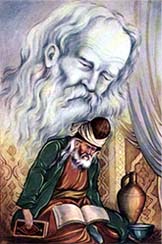 Mevlana
who is also known as Rumi, was a philosopher and mystic of Islam, but not a
Muslim of the orthodox type. His doctrine advocates unlimited tolerance,
positive reasoning, goodness, charity and awareness through love. To him and
to his disciples all religions are more or less truth. Looking with the same
eye on Muslim, Jew and Christian alike, his peaceful and tolerant teaching
has appealed to men of all sects and creeds. Mevlana
who is also known as Rumi, was a philosopher and mystic of Islam, but not a
Muslim of the orthodox type. His doctrine advocates unlimited tolerance,
positive reasoning, goodness, charity and awareness through love. To him and
to his disciples all religions are more or less truth. Looking with the same
eye on Muslim, Jew and Christian alike, his peaceful and tolerant teaching
has appealed to men of all sects and creeds.
Mevlana was born on 30 September 1207 in Balkh in present day Afghanistan He
died on 17 December 1273 in Konya inpresent day in Turkey . He was laid to
rest beside his father and over his remains a splendid shrine was erected.
The 13th century Mevlana Museloum with its mosque, dance hall, dervish
living quarters, school and tombs of some leaders of the Mevlevi Order
continues to this day to draw pilgrims from all parts of the Muslim and
non-Muslim world.

Sample Mevlevi Music
Whirling Dervishes
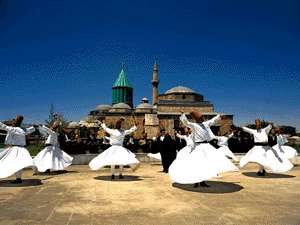 The "dance" of the Whirling Dervishes is called Sema. Sema is a part of the
inspiration of Mevlana as well as part of the Turkish custom, history,
beliefs and culture.
The "dance" of the Whirling Dervishes is called Sema. Sema is a part of the
inspiration of Mevlana as well as part of the Turkish custom, history,
beliefs and culture.
Sema represents a mystical journey of man's spiritual ascent through mind
and love to "Perfect." Turning towards the truth, his growth through love,
desert his ego, find the truth and arrive to the "Perfect," then he return
from this spiritual journey as a man who reached maturity and a greater
perfection, so as to love and to be of service to the whole of creation, to
all creatures without discrimination of believes, races, classes and nations
Sema is part of the inspiration of Mevlana Celaleddin-i Rumi (1207- 1273) as
well as of Turkish custom, history, beliefs and culture.
From a scientific viewpoint we witness that contemporary science definitely
confirms that the fundamental condition of our existence is to revolve.
There is no object, no being which does not revolve and the shared
similarity among beings is the revolution of the electrons, protons and
neutrons in the atoms, which constitute the structure of each of them. As a
consequence of this similarity, everything revolves and man carries on his
live, his very existence by means of the revolution in the atoms, structural
stones of his body, by the revolution of his blood, by his coming from the
earth and return to it, by his revolving with earth itself. However, all of
these are natural, unconscious revolutions. But man is the possessor of a
mind and intelligence which distinguishes him from and makes him superior to
other beings. Thus the "whirling dervish" or Semazen causes the mind to
participate in the shared similarity and revolution of all other beings
Otherwise, the Sema ceremony represents a mystical journey of man's
spiritual ascent through mind and love to "Perfect." Turning towards the
truth, his growth through love, desert his ego, find the truth and arrive to
the "Perfect," then he return from this spiritual journey as a man who
reached maturity and a greater perfection, so as to love and to be of
service to the whole of creation, to all creatures without discrimination of
believes, races, classes and nations.







 Sema
consists of seven parts. Sema
consists of seven parts.
The first part:
The dervish with his headdress (his ego's tombstone), his white skirt (his
ego's shroud) is by removing his black cloak spiritually born to the truth,
he journeys and advances there. At the onset and each stop of the Sema,
holding his arms crosswise he represent the number one, and testifies to
God's unity. While whirling his arms are open, his right hand directed to
the skies ready to receive God's beneficence, looking to his left hand
turned toward the earth, he turn from right to left around the heart. This
is his way of conveying God's spiritual gift to the people upon whom he
looks with the eyes of God. Revolving around the heart, from right to left,
he embraces all the mankind, all the creation with affection and love
It
starts with an eulogy "Nat-I Serif" to the Prophet, who represents love, and
all Prophets before him. To praise them is praising God, who created all of
them.
The second part is a drum voice,
symbolizing God order to the Creation: "Be."
The third part is an instrumental improvisation "taksim" with a reed "ney."
It represents the first breath which gives life to everything. The Divine
Breath.
The fourth part is the "dervishes" greetings to each other and their thrice
repeated circular walk "Devr-i Veled," with the accompaniment of a music
called "peshrev." It symbolize the salutation of soul to soul concealed by
shapes and bodies.
The fifth part is the Sema (whirling). It consists of four salutes or "Selam"s.
At the end of each as in the onset, the dervish testifies by his appearance
to God's unity.
The first salute is man's birth to truth by feeling and mind. His complete
conception of the existence of God as Creator and his state of creature.
The second salute expresses the rapture of man witnessing the splendor of
creation, in front of God's greatness and omnipotence.
The third salute is the transformation of rapture into love and thereby
the sacrifice of mind to love. It is a complete submission, it is
annihilation of self with in the loved one, it is unity. This state of
ecstasy is the highest grade in Buddhism, defined as "Nirvana" and in Islam
"Fenafillah." However, the highest rank in Islam is the rank of the Prophet,
he is called God's servant first and his messenger afterwards. The aim of
Sema is not unbroken ecstasy and loss of conscious thought. At the
termination of this salute, he approves again by his appearance, arms
crosswise the Unity of God, consciously and feelingly.
The forth salute Just as the Prophet ascends till the "Throne" and then
returns to his task on earth, the whirling dervish reaching the state of "Fenafillah,"
return to his task in creation, to his state of subservience following the
termination of his spiritual journey and his ascent. He is a servant of God,
of his Books, of his Prophets and all his creation.
At the sixth part Sema ends with a reading of the Quran and specially of the
verse from sura Bakara 2, verse 115, "Unto God belong the East and the West,
and whither over ye turn, you are faced with Him. He is All-Embracing,
All-Knowing."
The seventh part is a prayer for the repose of the souls of all Prophets and
all believers.
MEVLANA MUSEUM
 Mevlana
Dergahi (Dervish Lodge) which is presently used as a museum formerly the
Rose Garden of the Seljuks Palace and it was given as a gift to Mevlana's
father Sultanü'l-Ulema Bahaaeddin Veled by Sultan Alaeddin Keykubad Mevlana
Dergahi (Dervish Lodge) which is presently used as a museum formerly the
Rose Garden of the Seljuks Palace and it was given as a gift to Mevlana's
father Sultanü'l-Ulema Bahaaeddin Veled by Sultan Alaeddin Keykubad
When Sultanü'l-Ulema died on 12 January 1231, he was buried the present
grave which is in the mausoleum. This was the first burial ever take place
in the Rose Garden. After the death of Sultanü'l-Ulema, his friends and
disciples approached Mevlana and told of their wish to build a maussoleum
over his grave. Mevlana refused this request remarking "How could there be a
better mausoleum than the sky itself?). However when he died on 17 December
1273, his son Sultan Veled accepted the request of those who wanted to build
a maussoleum over Mevlana's grave. The mausoleum called "Kubbe-i Hadra"
(Green mausoleum) was built by the architect Bedrettin from Tebriz for
130,000 Seljuk dirhem (currency) on four elephant feet (thick columns).
After this date, the construction activities never ceased and continued in
stages up to the end of the 19th century.
Mevlevi Derhgahi (Dervish Lodge) and the mausoleum started to function as a
museum in 1926 under the name of Konya Museum of Historical Works. In 1954
the display pattern of the museum was once more taken up and it was renamed
as the Mevlevi Museum.
While the Museum originally covered an area of 6,500m² together with its
garden, with the section expropriated later and designed as a rose garden,
it has today reached a size of 18,000m²
The courtyard of the museum is entered from "Dervisan Kapisi" (The gate of
the Dervishes). There are dervish cells along the north and west sides of
the courtyard. The south side, after Matbah and Hürrem Pasha mausoleums,
terminates with the gate of Hamusan (Sealed Lips) which opens to Üçler
cemetery. On the eastern side of the courtyard there is the mausoleums of
Sinan Pasha, Fatma Hatun and Hasan Pasha, the Samahane (Ritual Prayer Hall)
next to them and the small mosque (mesjidt) section and the main building
where the graves of Mevlana and his family members are also housed.
The courtyard is given a special flavor with the roofed washing fountain (sadirvan)
built by Sultan Yavuz Sultan Selim in 1512 and the "Seb-i Arus" (means
nuptial night or the night Mevlana passed away) pool and the fountain which
is located in the northern part of the court and called Selsebil.

" Tilavet " Chamber (Quran Reading And Chanting)
 Tilavet"
is an Arabic word which means reading the quran with a beautiful voice and
the correct rythim. The room takes its name from its function in the past.
At present it is used as the Calligraphy Department. Tilavet"
is an Arabic word which means reading the quran with a beautiful voice and
the correct rythim. The room takes its name from its function in the past.
At present it is used as the Calligraphy Department.
The calligraphy section contains the framed works of famous calliagraphs of
their time such as Mahmud Celaleddin, Mustafa Rakim, Hulusi, Yesarizade as
well as a gilt relief frame done by Sultan Mahmut II. The couplet in Farsi
engraved on the silver door with the calligraphy of Yesarizade Mustafa Izzet
Efendi says:
Kabetü'l-ussâk bâsed in mekam
Her ki nakis amed incâ sod temam
(Let this be the Kaaba of the minstrels. Who ever enters here in half, finds
himself whole)
Huzur-i Pir (Mausoleum)
The hall of the mausoleum is entered from a silver door which was donated in
1599 by Hasan Pasha, who is the son of Sokollu Mehmet Pasha. Here, the
oldest copies of the famous works of Mevlana the "Mesnevi" and "Divan-i
Kebir" are displayed in two glass fronted cabinets. The mausoleum hall is
roofed with three small domes The third dome which is also called the skin
dome joins, the green dome in the north.
The hall is bordered with a platform on its east, south and north sides. In
the north where there is a two level platform, the sarcophaguses of 6 Sacred
horasan men are placed. Right at the feet of these, the Target Stone, made
for Ilhanli King Ebu said Bahadir Khan.
There are also two framed inscriptions which are important as they reflect
the thoughts and philosophy Mevlana. The first frame is in Turkish and says
:
"Either seem as you are
Or be as you seem"
Hz. Mevlâna
Second frame is a quatrain of Mevlana in Persian. In translation it reads :
"Come, Come who or whatever you are
Should you be an unbeliever, a Magian or a pagan still come
Our lodge is not a lodge of despair
With hundred repentions unheeded you may be,still, come"
Hz. Mevlana
 On
the high platform bordering the mausoleum hall on the east and south there
are 55 graves, ten of which belong to ladies and the whole group belongs to
the family members of Mevlana, and his father. There are ten other graves
which belong to people such as Hüsameddin Çelebi, Selahaddin Zerkubi and
Sheyh Kerimüddin who had reached high ranks in the sect of Mevlevi. On
the high platform bordering the mausoleum hall on the east and south there
are 55 graves, ten of which belong to ladies and the whole group belongs to
the family members of Mevlana, and his father. There are ten other graves
which belong to people such as Hüsameddin Çelebi, Selahaddin Zerkubi and
Sheyh Kerimüddin who had reached high ranks in the sect of Mevlevi.
Right under the Green Dome there are the graves of Mevlana and his son
Sultan Veled. The double hunched marble sarcophagus over the graves was
donated 1565 by Süleyman the Magnificant. The quilt embrodieried with gold
thread placed over the sarcophagus is a Seljuk masterpiece and was made for
Mevlana in 1274. When Süleyman the Magnificent had a new marble sarcophagus
made over the graves of Mevlana and son, the original wood one was removed
and put over the grave of Mevlana's father.
Semâ-Hâne (Ritual Hall)
The Semahane section together with the small mosque was built by Süleyman
the Magnificent in the XVIth century.
Semah ceromonies were continued at this ritual hall until 1926, when the
Dergah (Dervish lodge) was converted to a museum. The Naat Pew in the Hall,
the place where the musicians set (Mutrib cells) and the sections for men
and women are preserved in their original state, while metal and glass
objects and musical instruments of the Mevlevi are displayed in glassed
cabinets and rugs of historical value are hung on appropriate walls of the
Semahane.
Mosque
 The
small mosque, or the mesjidt is entered from the Çerag (apprentice) Gate.
There are additional small entrances from the Semahane and the Huzur - Pir,
the cemetery. The place for the müezzin and the Mesnevihan Pew are kept in
their original state. The
small mosque, or the mesjidt is entered from the Çerag (apprentice) Gate.
There are additional small entrances from the Semahane and the Huzur - Pir,
the cemetery. The place for the müezzin and the Mesnevihan Pew are kept in
their original state.
Extremely valuable rug and wooden door samples are displayed on the south
wall of the mosque and in 10 glassed cabinets put around this space,
significant examples of binding, calligraphy and gilding are exhibited.
There are 17 small cells, each with a small dome and chimney around the west
and north sides of the front court of the Mevlana Lodge. These cells were
built in 1584 by Sultan Murat III to house the dervishes.
Four cells to the right of the entrance gate are at present used as a ticket
window and administration offices . The first two of the 13 cells to the
left of the gate used as "Postnisin" and "Mesnevi-han" cells are kept in
their origanal form and presented to the public.
The last two cells at the end are allocated to the very valuable book
collections donated by Abdülbaki Gölpinarli and Dr. Mehmed Önder, and they
are used as a library.
The partition walls of the remaining 9 cells were removed providing two
interconnected large corridors. In one of these corridors old rugs of
historical value from regions famous for their rugs such as Kula, Gördes,
Usak and Kirsehir are displayed while the other has old rugs from districts
of Konya such as Ladik, Karaman, Karapinar and Sille which are centers of
rug weaving. Display windows built in the window and door sills of these
cells display artifacts of Mevlevi ethnography such as "Pazarci masasi", "Mütteka",
"Nefir" which were transferred to the museum from the Lodge, and the
extremely valuable Bursa fabrics from the museum collection
Matbah (Kitchen) Section
The kitchen is on the south west corner of the museum. It was built by
Sultan Murat II in 1548. Until the lodge was converted to a museum in 1926
the meals were being provided from here.
This section was restored in 1990 and the display was rearranged with
mannequins. Cooking, the basic function of the kitchen and the "somat" the
special table routine, is demonstrated with mannequins. Another such
illustration was attempted, to show the other function of the kitchen which
is related to the initiations of the novice, called "Nev-ni-yaz", and
involves practice of Semah.
| Sema: Human Being in the Universal Movement
Sema is part of the inspiration of Mevlana Celaleddin-i Rumi (1207-
1273) as well as of Turkish custom,
history, beliefs and culture.
From a scientific viewpoint we witness that
contemporary science definitely confirms that the fundamental condition
of our existence is to revolve. There is no object, no being which does
not revolve and the shared similarity among beings is the revolution of
the electrons, protons and neutrons in the atoms, which constitute the
structure of each of them. As a consequence of this similarity,
everything revolves and man carries on his live, his very existence by
means of the revolution in the atoms, structural stones of his body, by
the revolution of his blood, by his coming from the earth and return to
it, by his revolving with earth itself.
However,
all of these are natural, unconscious revolutions. But man is the
possessor of a mind and intelligence which distinguishes him from and
makes him superior to other beings. Thus the "whirling dervish" or
Semazen causes the mind to participate in the shared similarity and
revolution of all other beings
Otherwise, the Sema ceremony represents
a mystical journey of man's spiritual ascent through mind and love to
"Perfect." Turning towards the truth, his growth through love, desert
his ego, find the truth and arrive to the "Perfect," then he return from
this spiritual journey as a man who reached maturity and a greater
perfection, so as to love and to be of service to the whole of creation,
to all creatures without discrimination of believes, races, classes and
nations.
|
 Sema
consists of seven parts. Sema
consists of seven parts.
The first part
The dervish with his headdress (his ego's tombstone), his white skirt
(his ego's shroud) is by removing his black cloak spiritually born to
the truth, he journeys and advances there. At the onset and each stop of
the Sema, holding his arms crosswise he represent the number one, and
testifies to God's unity. While whirling his arms are open, his right
hand directed to the skies ready to receive God's beneficence, looking
to his left hand turned toward the earth, he turn from right to left
around the heart. This is his way of conveying God's spiritual gift to
the people upon whom he looks with the eyes of God. Revolving around the
heart, from right to left, he embraces all the mankind, all the creation
with affection and love
It starts with an eulogy "Nat-I Serif" to the
Prophet, who represents love, and all Prophets before him. To praise
them is praising God, who created all of them.
The second part is a drum
voice,
symbolizing God order to the Creation: "Be."
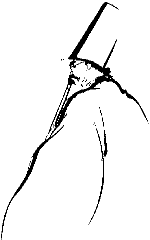 The
third part is an instrumental improvisation "taksim"
with a reed "ney." It represents the first breath which gives life to
everything. The Divine Breath. The
third part is an instrumental improvisation "taksim"
with a reed "ney." It represents the first breath which gives life to
everything. The Divine Breath.
The fourth part is the
"dervishes" greetings to each other and their thrice repeated circular
walk "Devr-i Veled," with the accompaniment of a music called "peshrev."
It symbolize the salutation of soul to soul concealed by shapes and
bodies.
The fifth part is the Sema
(whirling). It consists of four salutes or "Selam"s. At the end of each
as in the onset, the dervish testifies by his appearance to God's unity. |
- The first salute is man's birth to truth by feeling
and mind. His complete conception of the existence of God as Creator
and his state of creature.
- The second salute expresses the rapture of man
witnessing the splendor of creation, in front of God's greatness and
omnipotence.
- The third salute is the transformation of rapture
into love and thereby the sacrifice of mind to love. It is a complete
submission, it is annihilation of self with in the loved one, it is
unity. This state of ecstasy is the highest grade in Buddhism, defined
as "Nirvana" and in Islam "Fenafillah." However, the highest rank in
Islam is the rank of the Prophet, he is called God's servant first and
his messenger afterwards. The aim of Sema is not unbroken ecstasy and
loss of conscious thought. At the termination of this salute, he
approves again by his appearance, arms crosswise the Unity of God,
consciously and feelingly.
- The forth salute Just as the Prophet ascends till
the "Throne" and then returns to his task on earth, the whirling
dervish reaching the state of "Fenafillah," return to his task in
creation, to his state of subservience following the termination of
his spiritual journey and his ascent. He is a servant of God, of his
Books, of his Prophets and all his creation.
|
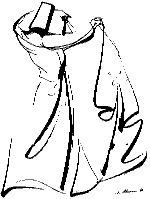
First Salute
|

Kiss of hand
Permission to whirl (dance) |
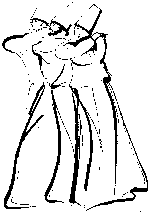
Second Salute
|
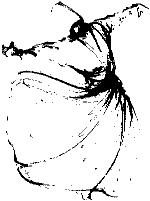
Third Salute - Whirling
|
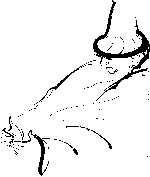
At the sixth part Sema ends
with a reading of the Quran and specially of the verse from sura Bakara
2, verse 115, "Unto God belong the East and the West, and whither over
ye turn, you are faced with Him. He is All-Embracing, All-Knowing."
The seventh part is a prayer
for the repose of the souls of all Prophets and all believers.
|
Useful
Links : www.mevlana.org
, www.sufism.org ,
www.emav.org
|



![]()